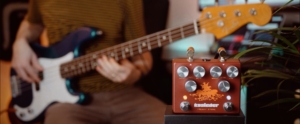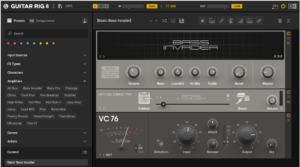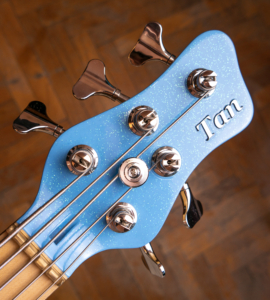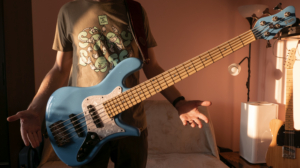Fuzzaliciousness
First off, let me just say that I am not a fuzz-head.
Although I thoroughly appreciate a good buzzy bass fuzz sound, the band I play in usually needs a more ‘concrete’ type of distortion.
This, combined with the fact that I’m a minimalist when it comes to playing shows, means that I try to be wary of what I carry with me to gigs. Coming after a longer period of using no pedals on stage, in the last few years I’ve been using a small utilitarian pedalboard with some bare essentials – a tuner, a great preamp/di, a distortion or two and sometimes for an added flavour either an octaver or a delay. Now that I started using a synth regularly, the octaver will no longer be gracing the board with its presence so I’d have some free space.
But why would I use a fuzz on my pedalboard if I am not much of a fan?
Well, mostly because the Freaky Stone is what I call a “Two Tone” pedal, meaning you can get 2 distinct sounds from one single pedal. Call it versatility, call it what you will, I’ve always favoured this approach.
Kasleder FX
is a small boutique-pedal shop from Hungary, founded and operated by Albert Kasléder, who already made a name for himself as a pedal builder while working on a pedal series for Höfner guitars. His stompboxes usually gravitate around the vintage type of sound/era, but with an updated and personal twist.
The Freaky Stone
Let’s begin with an excerpt from the Kasleder website:
“Paul McCartney, John Paul Jones, Gene Simmons, Paul Simonon, Lemmy, Steve Harris, Duff McKagan, Tim Commerford. A few names of the bass players with special playing style, but most of all a special sound timbre of the bass with a big impact on me and still do have to this day. They all have different, unique flavors, but the common point is that they used lightly or roughly cracked amps.
This special cavalcade of flavors inspired the creation of the Freaky Stone pedal. I wanted to make a versatile pedal with the basic character of germanium transistors, giving the pedal a kind of vintage feel. So the Freaky Stone is a character pedal designed specifically for bass players, which you can also use as a preamp, overdrive, or fuzz.”
The Freaky Stone is an ultra limited edition bass preamp/overdrive/fuzz box, only 50 units ever made. Hand-built, numbered and signed, using top notch components – all nifty boutique pedal traits from a small shop in Budapest, Hungary.

Packaging/Design
They say first impressions are lasting ones, Kasleder pedals shine in this category and the Freaky Stone is no exception. Snugly packed into a logo-stamped cardboard box, it comes with its own bag, a coaster, a sticker and a pick. These might seem little things to some, but they are a nice personal touch and we all know that a little goes a long way. Of course, I just had to do an unboxing in the video demo, there was no way around it!
One thing I always liked about Albert’s pedals are the wide variety of colours they are available in. The Freaky Stone comes in what I’d call Boom Bass Brown because it certainly presents itself as a prime candidate for ‘brown note’ jokes, especially while blasting it through a full PA system.
The quirky and awesome graphics are made by Albert’s partner, Eszter Budavári and they are the icing on the cake.
Buildwise
the pedal seems very road worthy, the aluminium knobs feel nice and sturdy to the touch. I am not a tech/spec nerd, you can consult the product page of the pedal to access all that type of info. What I did retain, though, is the use of New Old Stock Russian military grade Germanium transistors, which give the Freaky Stone its unique flavour.
The controls
are straightforward and offer a wide range of combinations. One interesting fact, and you can fully observe this in the demo, is how differently the pedal responds to passive vs active instruments. The affected frequencies are mostly in the higher register and they give a very interesting sizzle to the active basses. The internal DIP switch and BIAS trim pot offer additional tweaking abilities for the tweak-nerds out there. As a side note, the BIAS trimpot was fully counterclockwise for all playing examples in the demo.
The HIGH control on the Boost section might be a bit too much or noisy for my taste, I’ve found that I’ve always preferred turning it down rather than up while testing the pedal without a musical context. Of course, things are different in a band setting as you can see in the demo, especially in the amp+mic and amp/cab sim sections.
Soundwise
I hate to use cliches but given the many ‘one trick pony’ fuzz pedals out there, this one might be more ‘versatile’ than the average. You have the fuzz section that delivers organic tones from bee-like buzz to full-blown firestorm. On the other hand, you can use the ‘cleaner side’ just for some EQ-ing and some saturation, maybe a bass/treble bump for a slap sound or maybe even to throw some more kerosene on the fuzz-fire, there are tons of options.
As always, these types of pedals sound best through an appropriate rig, of course. However I did find that the Freaky Stone works great with amp/cab sims as well, as you’ll be able to tell after watching the demo. One thing I forgot to mention, though, is what kind of amp/sim I used for that certain portion of the video. It was the newly released Guitar Rig 6 from Native Instruments with the Basic Bass Invader preset.

All in all
this pedal will definitely find its way on to my gigging pedalboard. I am still not a fuzz-head and although the pedal is not perfect (there are no perfect pedals) – I love the tone but could live without the inherent noise of fuzzpedals – I am looking forward to blasting some fuzzalicious Freaky Stone tones through some serious PA systems.
May 2021 mark the return (albeit gradual) of live shows and more music in our lives in general!
–
So, without further ado, please check out the demo if you haven’t already.
*although I am not a fuzz-head, this is not the first bass fuzz I owned – I have a Red Fuzz devil of a pedal built for me by my old friend Lorand, the man behind LoCo pedals and the Sensei preamp pedal which will be featured in a future demo/review. Stay tuned!
**disclaimer – this is not a sponsored review/demo but I did receive the pedal for free to test it.
For availability, pricing and more info, check Kasleder Freaky Stone page.
A Happy New Year to you guys!
stay safe!




